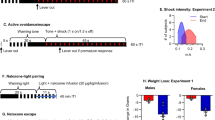Abstract
The reinforcing properties of etonitazene, both conditioned and unconditioned, were measured in rats that had received saline only by continuous intravenous infusion (“saline” group) and in two groups of rats that had been physically dependent on morphine to equal degrees (and presumably had developed equal degrees of tolerance to morphine): one by once daily passive intravenous injection of morphine (“injection” group) and the other by passive continuous intravenous morphine infusion at the same daily doses for approximately the same number of days (“infusion” group). Prior to passive saline and morphine administration, all rats were trained to press right and left-sided levers for water reinforcement from 1600 to 0800 hrs to a not more than 60–40 split, and these and other measures (“baselines”) were repeated after recovery from the early (acute) morphine-abstinence syndromes. Then etonitazene, 5 μg/ml, was substituted for water on the nonpreferred side and all measures were repeated from 1600 to 0800 hrs once every two weeks for 20 weeks (10 “relapse” tests). It was postulated that the daily cycles of morphine-abstinence and suppression of abstinence in the injection group only would generate latent interoceptively conditioned reinforcing properties of morphine because of conditioning of suppression of abstinence to the concomitant internal sensorial effects of morphine, which would persist after morphine withdrawal and be transferred to the internal effects of another opioid, etonitazene. It was found that across the first nine relapse tests, the injection group consumed significantly more etonitazene than the infusion group, while there were no significant differences in water consumption. Also, the number of response-contingent etonitazene drinking tube presentations in the first 30 min period of lever availability in the first relapse test (when the unconditioned reinforcing effects and other pharmacological actions of etonitazene were minimal) was significantly greater for the injection group than for either the infusion or saline group, whereas there were no significant differences among the three groups in response-contingent water tube presentations. These findings support the interoceptive conditioning hypothesis.
Similar content being viewed by others
References
Carroll, M. E. and Meisch, R. A.: Etonitazene as a reinforcer: oral intake of etonitazene by rhesus monkeys. Psychopharmacology59, 225–229, 1978.
Chernov, H. I., Ambrose, F. G. and Plummer, A. J.: Pattern of consumption of etonitazene solutions by naive rats.In Proc. Committee on Problems of Drug Dependence, NAS-NRC, 29th meeting, 13–16 Feb. 1967, Lexington, Ky. National Academy of Sciences, Washington, D. C., 1967 (Appendix 25, pp. 5040–5048).
Davis, W. M. and Smith, S. G.: Role of conditioned reinforcers in the initiation, maintenance and extinction of drug-seeking behavior. Pavlov. J. Biol. Sci.11, 222–236, 1976.
Dougherty, J. A., Miller, D. B. and Wikler, A.: Interoceptive conditioning through repeated suppression of morphine abstinence. I. Basis for conditioning: once-dailyvs. continuous intravenous morphine infusion. Pavlov. J. Biol. Sci.14, 160, 1979.
McMillan, D. E., Leander, J. D., Wilson, T. W., Wallace, S. C., Fix, T., Redding, S. and Turk, R. T.: Oral ingestion of narcotic analgesics by rats. J. Pharmocol. Exp. Ther.196, 269–279, 1976.
Meisch, R. A. and Stark, L. J.: Establishment of etonitazene as a reinforcer for rats by use of schedule-induced drinking. Pharmacol. Biochem. Behav.7, 195–203, 1977.
Wikler, A., Martin, W. R., Pescor, F. T. and Eades, C. G.: Factors regulating oral consumption of an opioid (etonitazene) by morphine-addicted rats. Psychopharmacologia5, 55–70, 1963.
Wikler, A. and Pescor, F. T.: Classical conditioning of a morphine-abstinence phenomenon, reinforcement of opioid-drinking behavior and “relapse” in morphine-addicted rats. Psychopharmacologia10, 255–284, 1967.
Wikler, A. and Pescor, F. T.: Persistence of “relapsetendencies” of rats previously made physically dependent on morphine. Psychopharmacologia16, 375–384, 1970.
Wikler, A., Norrell, H. and Miller, D.: Limbic system and opioid addiction in the rat. Exp. Neurol.34, 543–547, 1972.
Wikler, A.: Dynamics of drug dependence. Implications of a conditioning theory for research and treatment. Arch. Gen. Psychiat.28, 611–616, 1973.
Wikler, A.: Opioid antagonists and deconditioning in addiction treatment.In Boström, H. Larsson, T. and Ljungstedt, N. (eds.): Drug Dependence-Treatment and Treatment Evaluation, Skandia International Symposium, 15–17 October 1974. Stockholm, Almqvist and Wiksell International, 1975. pp. 157–184.
Winer, B. J.: Statistical Principles in Experimental Design. New York, McGraw-Hill, 1962. pp. 298–378.
Author information
Authors and Affiliations
Additional information
Supported by the Medical Research Service of the Veterans Administration and by N.I.D.A. Grant No. DA-01131, awarded to A. Wikler.
Rights and permissions
About this article
Cite this article
Miller, D.B., Dougherty, J.A. & Wikler, A. Interoceptive conditioning through repeated suppression of morphine-abstinence. Pav. J. Biol. Sci.. 14, 170–176 (1979). https://doi.org/10.1007/BF03001978
Issue Date:
DOI: https://doi.org/10.1007/BF03001978




